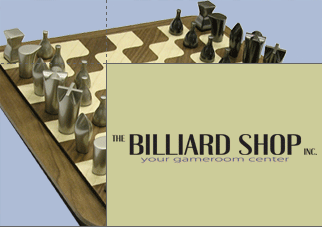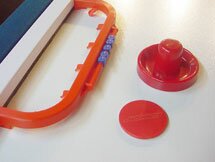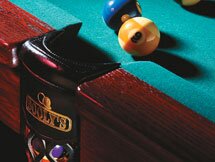
|
|||||||
 |
| Quick Answers |
| Pool Table Answers |
| Pool Cue Answers |
 |
 |
|
|||||||||||
|
Should I have a case for my cue? Yes. If you are willing to invest some money into a pool cue then invest a few extra dollars towards a cue case. A case will help protect your cue from damage as well as help protect it from humidity and moisture. How should I store my cue? The best place to store your cue would be in its case. This will also ensure that your cue is well protected. Ideally you want to keep your cue in normal (average) temperatures. Keep your cue away from very humid, warm or cold environments. A car would be the worst place to keep your cue. Drastic temperatures changes are very harmful for cues. Remember, they are made of wood! How do I keep my cue clean? The easiest way to help keep your cue clean is by keeping your hands clean. This may sound strange but it is your hands that are in contact with your cue, especially the shaft. At the same time your cue will never stay as clean as when you bought it. At the Dooly’s ProShop we offer a wide range of cleaning products for your cue, whether wood, fiberglass or graphite cues. All cue care products sold at the ProShop are the exact same products we use here ourselves. What is a jump/break cue? A jump/break cue is a multi-purpose cue. It is designed primarily for jump shots. Jump/break cues have a second joint added just above the wrap line. Once the bottom piece of the cue is removed it eliminates about 50% of the cue’s weight, thus making it much lighter, therefore easier to jump a ball. The second design purpose of this cue would be a break cue. Some players prefer a different cue for breaking. Reasons for this would be, different weight, harder tip or just not wanting to break with their playing cue. It could also be used as a back-up cue should something happen to your primary cue. Why is chalked used? Chalk is used to increase friction between the tip and the ball. It’s this thin layer of chalk that gives the cue tip grip onto the ball. Chalk was actually invented before the tip was. Why do cues have wraps on them? Although some cues come without a wrap, most cues are designed with a wrap. The purpose of a wrap is to give the player extra grip on the cue. It also serves to absorb perspiration from the player’s hand. The most commonly used materials for wraps are nylon, leather, cork, and Irish linen being the most popular. Why are there different types of joints? There are primarily two different categories of joints, piloted and flat-faced, with several designs available. - A piloted joint is when the shaft insert protrudes further than the joint collar, in turn when the cue is screwed together that nipple would insert into a corresponding cavity in the butt’s joint collar. - A flat-faced joint wouldn’t have a protruding insert. The insert would finish flush with the joint collar, or there may not even be an insert at all. When the cue is screwed together the two joint faces would meet flush. Most manufacturers have their own joint design or have a modified version of the above-mentioned joints. Most people tend to agree that a piloted joint emits a “harder” feel to the cue compared to the flat-faced joint. Although some people argue that as long as the joint is tightened properly, the joint design isn’t all that important. Why are there different tip sizes? Most pool cue manufacturers offer tip sizes that vary between 12 and 14mm, with 13mm being the most common. Snooker tips vary in sizes between 9 and 11mm. The reason why snooker tips are smaller is because snooker balls are smaller than pool balls and therefore the tip size is also smaller. Do you need a ferrule on a cue? The ferrule adds strength to the end of the cue and prevents the shaft from cracking, splintering or chipping. When should I re-tip my cue? We suggest that when the sidewall of the tip gets to be less than the thickness of a dime it is time to replace the tip. If the tip gets to be too thin it puts too much stress on the ferrule and that is generally when ferrules will crack. When I roll my cue I see light under the shaft. Does this mean it’s warped? Keep in mind that a cue is made from wood, an organic material. Do not expect your cue to be perfectly straight, especially the shaft. The biggest misconception is that a cue is warped when you are able to see light under the cue or shaft. It is normal that you will be able to see light movement under the cue while it is being rolled. The reason for this is that most all shafts are tapered. As a result, that is why it is normal that you will always be able to see movement in the shaft. It would be impossible for someone to notice that little of a variation in the shaft while stroking the shaft through ones fingers. What is a taper? According to the 1998 Merriam-Webster Dictionary Home & Office Edition, a “taper” is defined as “to make or become gradually smaller towards one end” (529). There are two types of tapers, the “European taper” and the “pro taper”. - The European taper, which is also commonly know as a straight taper, simply means the shaft is cone shaped. The diameter gradually and consistently increases from the tip to the joint. - The pro taper, on the other hand, will remain the same diameter size for some distance before gradually increasing for the remaining distance to the joint. For what is considered a pro taper, there are small and large pro tapers. A “small taper” is considered to be four to eight inches of cylindrical shape, while a “large taper” is considered to be ten to fifteen inches of cylindrical shape. Each cue manufacturer is different but most shafts have some type of pro taper, whether it is a small or large pro taper. The reason for a pro taper is that while stroking the shaft through your fingers, it will generally stay consistent is size. What is side pressure? Side pressure is any force exerted upon a cue from the side. Cues are designed to withstand significant straight-line impact from the cue tip making contact with the cue ball. Results of side pressure may not be evident right away. Problems may begin with internal damage, and eventually that damage will work its way from the inside out. Most cues, regardless of joint styles or materials, are not built to withstand side pressure that can result from a number of circumstances: - leaning your cue against the pool table, chair or stool - leaning your cue against the wall - dropping your cue on the ground - laying your cue on the pool table with it’s butt on the rail - breaking with too much follow through - moving the balls with your cue - hitting or slamming your cue against anything in frustration If you must lean your cue against a wall, do so at the slightest possible angle away from foot traffic. Obtain a cue holder. Lay your cue flat on the bed of the table. (This will also make the oncoming player wait until you are ready). These suggestions may sound very simple, but they will go a long way to maintaining the life of your cue. And remember, “no one will take care of your cue like you will.” |
|||||||||||
Email: Web: www.thebilliardshop.com
Telephone: (902) 490-0001 Fax: (902) 490-0002